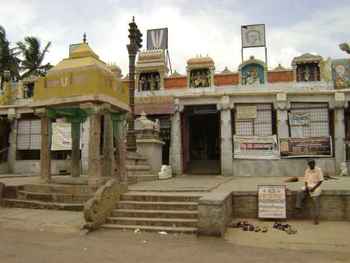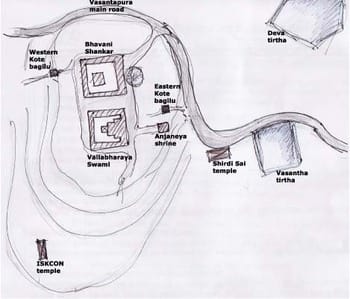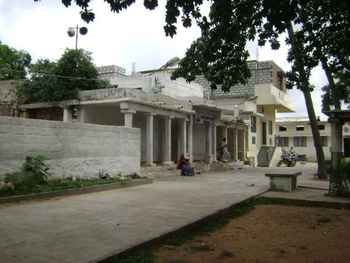B L Rice, who was the director of Archeology in the Mysore state from 1884, described Vasantapura village in the 1887 Mysore Gazette as, “a village 5 miles south of Bangalore. Population 112. It is in no way remarkable but for an old temple of Vallabharaya Swami which is a favourite resort for native wedding parties from Bangalore”, and thus dismissed it.
However, I decided it would be interesting to see how the place fared today given Bangalore’s exponential growth in all directions and so set out one day heading south on Kanakapura road past the Banashankari temple. I took the right turn at Konanakunte Cross, just after Metro, onto Vasantapura main road, which in the usual manner of village roads meandered for about 2 kms before turning into a large cricket ground-sized clearing in front of the temple of Vallabharaya swami.

Vallabharaya Swami Temple. Pic: Krupa Rajangam.
Prominent in the clearing was the temple fore-court while at one end of it was a small shrine to a local goddess. To my left was an ancient looking shrine housing a fairly tall stone relief carving of Anjaneya. There were a number of vendors scattered about the clearing selling puja items like garlands, lemons, coconuts and betel leaf. My attention was caught by a small four-pillared mantapa like structure right next to the Anjaneya shrine.
On enquiring, the priest of the Anjaneya shrine informed me that the mantapa was originally one of the bagilus or gates, which led in to the temple complex. A resident standing nearby piped in to add that this was one of four original gates, one in each of the cardinal directions and only two remained, the eastern one I had enquired about and the western one behind the temple complex. He offered to guide me to the other gate and we set off.
A short walk on a well-defined path behind the main temple soon led us to the Western gate; very similar to the one I had left behind. My guide, Vasanta informed me that the path had been recently done up in order to ease the movement of the processional chariot during the annual Jatre.

Sketch of site map. Courtesy: Krupa Rajangam.
Looking through the gate I had an uninterrupted view of the valley all-around with row upon row of new development, like Prashanti Nagar, Devakere Extension etc. The village of 112 appeared to have swelled to thousands and most of the mud huts with tiled roofs, of my imagination, had been replaced by cement and concrete structures. Looking back, the original shrine to Vallabharaya also appeared to have been extensively altered and added to.
Vasantha explained, according to sthalapurana, in ages past, when Bangalore was known as Kalyanpuri, Vasantapura was a forest where sages sat in meditation, but, the trees gradually gave way to fields and cultivated land when people would come to the shrine on bullock carts, crossing several tirthas (springs) on the way uphill. The muddy cart track has since been tarred and only two of the tirthas survive, even these not true to their original expanse.
The tirthas, five in number, namely Devatirtha, Vasanthatirtha, Shankatirtha, Chakratirthaand Plavatitirtha, are important because legend states that Lord Vallabharaya came to this spot to bathe in them after his marriage to Goddess Lakshmi at Narayana Vana near Tirupathi. The two surviving ones are Devatirtha and Vasantatirtha; the others have been filled up and converted into real estate plot.

Vasantha Thirtha, one of the two remaining tanks. Pic: Krupa Rajangam.
I asked Vasantha about the change. He said that residents generally view change positively, as a step towards development, in spite of the fact that the progress appears to be erratic at best. The neighbourhood ails from a host of issues like lack of proper solid waste management, assured water and power supply.
So should one be concerned with the lost identity of the place as a small village? Or does it not matter as long as the temple and its rituals continue to exist in some form or the other since the identity of the place is tied in with the temple?
Here, Vasanta assured me that like in the past, village life continued to largely revolve around the temple and its activities. After all the sacred spot is one of the few Hari Hara Kshethras of the region. Hari, as in Lord Vishnu and Hara as in Lord Shiva with the Vallabharaya temple dedicated to Vishnu and the Bhavani Shankar temple to Shiva.
Historically the former is supposed to have been set up by the Cholas, while the latter situated to the north of Vallabharaya temple is said to have been established by Shivaji when he camped on the hill during the course of one of his military manoeuvres.(Bhavani Shankar is Shivaji’s family deity). However, sthalapurana states that a vision led Sage Mandavya, who was in meditation in the Guptagiri cave nearby, to this spot where he found a Svayambhu image of Vallabharaya.

Bhavani Shankar temple. Photo credit: Krupa Rajangam.
I entered the temple office to meet Shantakumar, Secretary, Vallabharaya Utsava Samithi, which has also taken up development work in and around the temple as part of its mandate. He led me straight to the sanctum sanctorum to point out the small Svayambhu idol discovered by Sage Mandavya, next to the larger idol of Vallabharaya. He also took me around the temple pradakshina patha and pointed a spot where the Samithi shortly hopes to install a sculpture of the sage. He also pointed out the statues of the Alwars within the temple, dating from Chola times.
Shantakumar said that the site continued to be extremely popular for kalyanotsavas and a theppotsava is arranged, in one of the two remaining tirthas, every year in February along with the brahmotsava jatre when the processional idol is taken around the temple complex. (The next brahmotsava will take place of January 31st 2010 and Guptagiri cave will be open to public for guhe puja on the day before i.e. the 30th).
Further shrines have come up nearby including a Shirdi Sai temple to the southeast at the foot of the hill and an ISKCON temple to the south west within whose lands now lies the ‘Guptagiri’ cave described earlier on.The place may have transformed over time but the temple continues to be the heart of Vasantapura. ⊕
References
Lexicon:
- Pradakshina patha – circumambulatory path around the main shrine
- Alwars – the 12 Vaishnavite saints, partly credited with establishing the Bhakti movement, predominantly from Tamilnadu
- Brahmotsava – annual Temple festival
- kalyanotsavas – wedding ceremony procession for the principal deity
- theppotsava – ritual where idols are placed on a small float in the tank
- Svayambhu – self manifested
- sthalapurana – local mythology or history of a temple
Lovely article!
Must specially mention the beautiful breeze that greets you in the evenings around here. And of course, the temple(s).
digging out the jewels which are lost in time and space is a tough job… all my compliments to u Krupa. That was a real good insight.
hi all…
I have a question thats been bothering me for quiet some time. Heritage and culture always go hand in hand, one so deep rooted in time and the other so dynamic. Why is it that the heritage tends to get lost sooner than the culture??? Both are something which are nourished by the people themselves. But y does it become so easy for one to give up or rather compromise on the heritage than culture itself???
Thank you, Krupa! I just visited this temple yesterday and blogged about it, and I was thinking of asking if you could do a Heritage Walk here. But now I have got the information at my fingertips.